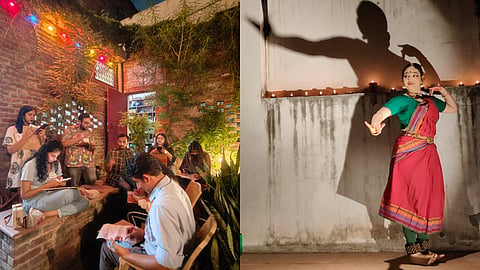
- HOMEGROWN WORLD
- #HGCREATORS
- #HGEXPLORE
- #HGVOICES
- #HGSHOP
- CAREERS
- ABOUT US
- CONTACT US

In outh Delhi’s Okhla industrial area, Red House stands as a unique cultural space. Once an electronics factory from the 1960s, it has been reimagined as a destination for art, workshops, performances, and community events. The transformation began in July 2022, led by Arjun Shivaji Jain, an artist and physicist, along with his sister, Sunaina Jain, a journalist and aspiring filmmaker. Together, they have turned their family’s old ferrite core transformer business into a thriving hub for creativity and collaboration.
Red House blends the past with the present. Inspired by John Ruskin and Laurie Baker’s architectural principles, Arjun spent years restoring the factory using sustainable materials like lime mortar instead of cement. The result is a space with Gothic arches, terracotta ceilings, and open courtyards — an escape from Delhi’s chaos.
The Multipurpose Hall, with its high ceilings and long, narrow layout, is designed to foster connection, hosting everything from workshops and concerts to plays and exhibitions. The Amphitheatre, surrounded by greenery and featuring a stage, provides a versatile outdoor venue. Even the Coilwinder’s Arms Café, steeped in the building’s industrial history, adds a cozy touch during events.
Red House is fundamentally a community. Known as “Residents”, its members actively shape its programming and identity. In just over two years, it has brought together over 2,500 in-person Residents and a digital community of more than 10,000 people.
The events are thoughtfully curated to engage and inspire — stone sculpture classes, dance festivals celebrating Rukmini Devi, and art trips to Naggar in honor of Nicholas Roerich are just a few examples. Red House also runs open calls for artists, giving emerging talent a platform to showcase their work and connect with audiences.
Red House serves as a space for local and international artists to connect with Delhi’s creative community. Its partnerships with institutions like the British High Commission and National Law University reflect its commitment to fostering meaningful cultural exchanges.
From intimate workshops to large public events, Red House aims to provide more than just a venue. It’s a place for people to engage, learn, and connect, making it a valuable addition to the city’s cultural fabric. Red House is a reminder that cultural spaces don’t need to be grand or exclusive to be impactful. By transforming a family factory into a community-driven hub, the Jain siblings have created something that feels both personal and purposeful.
For anyone looking to experience Delhi’s creative pulse, Red House offers a space where art and culture meet in meaningful ways.
Learn more here.
If you enjoyed reading this, here's more from Homegrown:
Whose Future Is It Anyway?: Is Bland, Uniform Minimalism Erasing Mumbai's Identity?
A Tactile Renaissance: How Cultural Spaces Are Addressing The Question Of Accessibility
Ghar 1964 Is A Haven That Brings The Warmth Of Home To The Hills Of Himachal Pradesh
